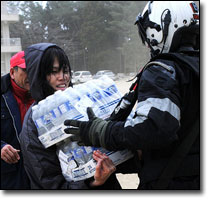Tag
earthquake
-
•
Quake damage could cripple Calif. hospitals
In her series on earthquake preparedness at California hospitals, California HealthCare Foundation Center for Health Reporting senior reporter Deborah Schoch…

-
•
Conference discusses reporting on disasters
While everyone’s attention was focused on some conference in Philadelphia, the Pulitzer Center for Crisis Reporting and Boston University were…

-
•
Journalist makes case against sanitizing disaster coverage
At a time when the ethics of anecdotal and emotion-heavy disaster coverage have come into question, as they tend to…

-
•
Journalists must heed ethics in disaster coverage
A little more than a week after the historic earthquake, tsunami and nuclear emergency in Japan, journalists are beginning to…

-
•
MSNBC tells of earthquake amputees, soldiers
In the aftermath of the Haiti earthquake, an MSNBC team has set out to cover, through a variety of media,…

-
•
Doctor or journalist? Roles become blurred in Haiti
As aid flows to Haiti and the full scope of the disaster becomes clear, there is an interesting discussion happening…


